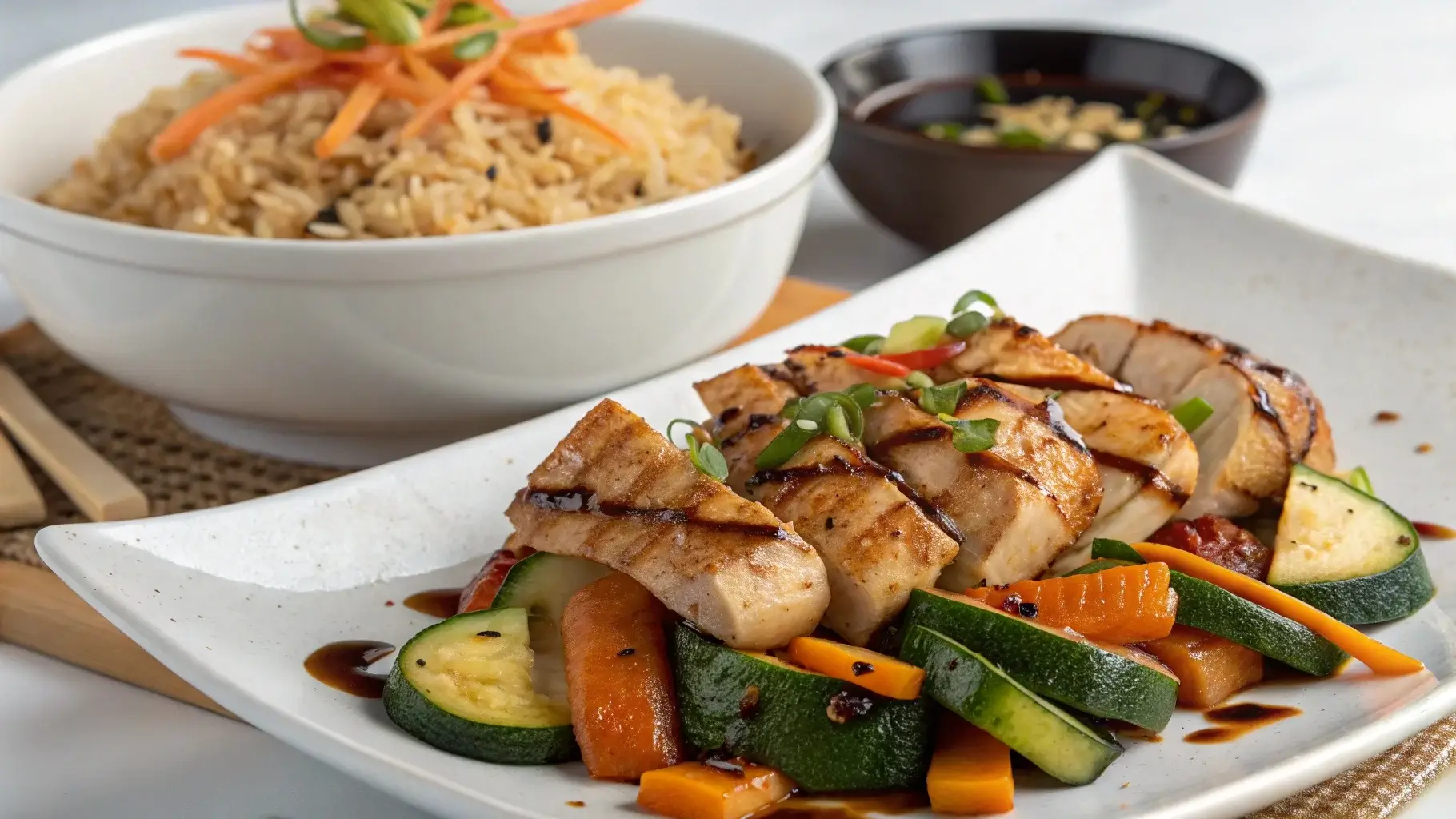Are you craving that Benihana-style goodness with tender, juicy chicken, sizzling vegetables, and rich, garlicky butter coating each bite? Well, you’re in the right place! This article walks you through everything you need to know about making a mouthwatering hibachi chicken recipe in your very own kitchen. From the best ingredients and cooking techniques to restaurant-style presentation and expert tips, we’ll break it down step by step.
And let’s not forget the sauces—yum yum sauce or garlic butter, anyone? With a bit of practice, you’ll be recreating that smoky, savory magic in no time! Plus, we’ll even show you how to add some personal flair to make this dish truly your own.
I still remember my first attempt at making hibachi chicken at home—it was a chaotic, funny experience! My best friend Momo (a self-proclaimed Japanese food expert) came over to help, and let’s just say we were not ready for the oil splatters or the high heat. We cranked up the stove to replicate that sizzling restaurant vibe, but things got messy fast. I’ll never forget Momo frantically waving a kitchen towel as the chicken crackled and the butter melted into a smoky pool. By the end, though, we sat down to a plate of slightly overcooked chicken, a heap of fried rice, and veggies that were…okay-ish. But guess what? The flavor was there. That was the moment I knew I could perfect it, and you can too!
Table of Contents
Introduction to Hibachi Chicken
What Is Hibachi Chicken?
Hibachi chicken is a popular Japanese dish cooked on a flat-top grill or griddle. The term “hibachi” refers to a traditional Japanese heating device, but when it comes to food, it’s all about that high-heat, quick-cooking style that locks in flavors while creating a distinct smoky taste. This dish typically features bite-sized pieces of chicken sautéed with soy sauce, garlic, and butter, often paired with veggies and fried rice.
Origins and Popularity in Japanese Cuisine
Although hibachi grilling originated in Japan, it gained massive popularity in the U.S. through teppanyaki-style restaurants like Benihana. Unlike traditional Japanese cuisine, which emphasizes subtle flavors, hibachi cooking leans toward bold, savory combinations that excite the palate. Its Americanized twist incorporates garlic butter, yum yum sauce, and fried rice, turning it into a complete meal that’s rich and satisfying.
Why Make It at Home Instead of Dining Out?
While dining at hibachi restaurants can be fun, making hibachi chicken at home has its perks. You can control the ingredients (say goodbye to excess salt or oil!), customize the flavors, and save money in the process. Plus, you won’t need a fancy flat-top grill—a simple skillet or pan will do the trick. Ready to become a hibachi pro? Let’s dive in!
Ingredients Breakdown for Hibachi Chicken
Essential Proteins: Chicken Selection and Preparation
The star of any good hibachi chicken recipe is the chicken itself. Boneless, skinless chicken breasts or thighs are ideal for this dish. Chicken thighs tend to be juicier and more forgiving when cooked, while breasts offer a leaner option. To ensure even cooking, cut the chicken into bite-sized pieces—about 1-inch cubes. Pat the pieces dry before cooking to help them sear properly. Seasoning is key: a simple salt, pepper, and garlic powder base works wonders.
Key Flavors: Soy Sauce, Sesame Oil, and Other Seasonings
What gives hibachi chicken that unmistakable, savory flavor is the combination of soy sauce and sesame oil. Soy sauce provides that salty umami kick, while sesame oil adds richness and nuttiness. A dash of mirin (Japanese sweet rice wine) or rice vinegar can enhance the depth of flavor. Garlic, ginger, and butter are essential for that aromatic boost. And don’t forget freshly squeezed lemon juice—it brightens up the dish beautifully.
Vegetables That Complement the Dish
Vegetables add balance to the meal and soak up the flavors of the soy and garlic. Common choices include zucchini, onions, carrots, and mushrooms. Bell peppers can add color and sweetness if you want more variety. Make sure the veggies are cut uniformly to ensure even cooking.
Special Add-Ons: Yum Yum Sauce and Garlic Butter
No hibachi experience is complete without yum yum sauce. This creamy, tangy sauce—typically made from mayonnaise, ketchup, and spices—perfectly complements the savory chicken. Garlic butter, made by blending softened butter with minced garlic, adds a luxurious finish to the dish.
Pro Tip: For more inspiration on perfect seasoning techniques, check out The Ultimate Guide to Blackstone Hibachi Recipes.
Step-by-Step Cooking Instructions
Preparing the Ingredients Before Cooking
Before you start cooking, gather all your ingredients. Cut the chicken and vegetables into similar-sized pieces, so they cook evenly. Prepare your sauces ahead of time—this way, you can easily drizzle them over the finished dish. Preheat your pan or griddle to medium-high heat to mimic that restaurant-style sear.
Cooking the Chicken: Techniques for Tender, Juicy Results
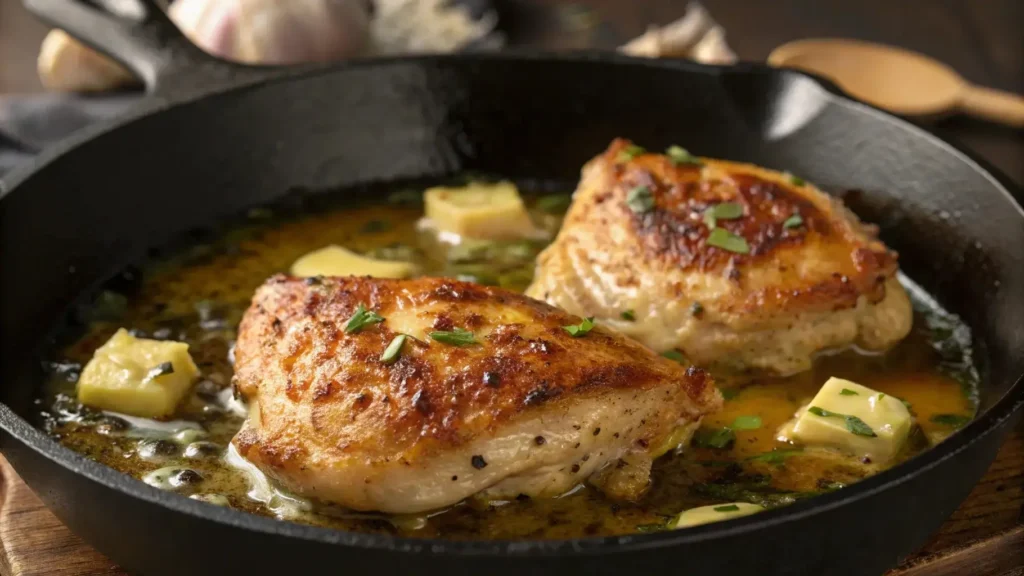
To achieve that perfect, golden-brown exterior on the chicken, preheat the pan and add oil (vegetable oil or sesame oil works best). Toss the chicken cubes with salt, pepper, and garlic powder. Place them in the pan in a single layer and let them cook undisturbed for 2-3 minutes before flipping. This allows the chicken to caramelize and develop a delicious crust. Once cooked through, set the chicken aside.
Stir-Frying the Vegetables to Perfection
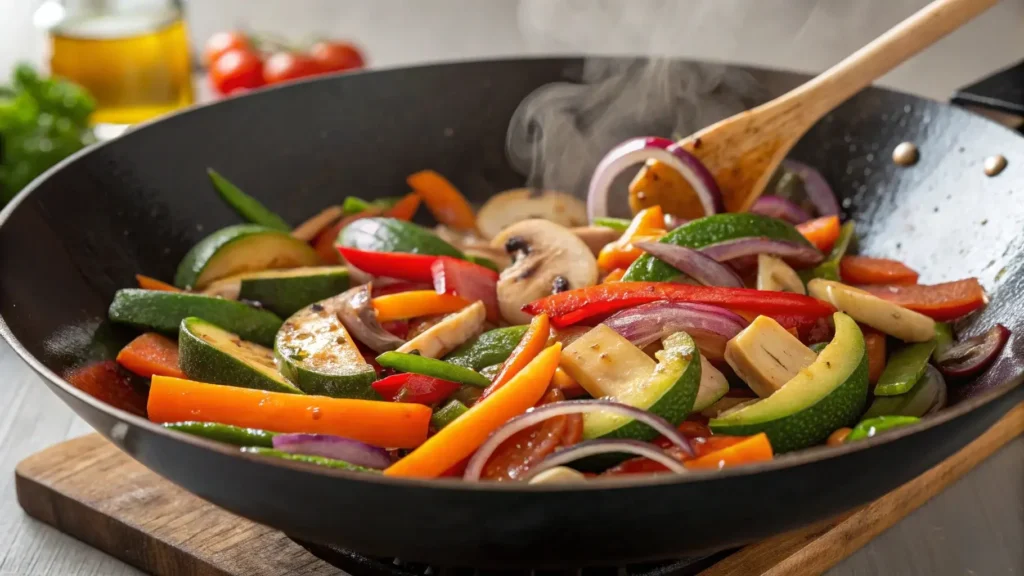
In the same pan, add a bit more oil and toss in the vegetables. Start with the heartier ones like carrots and onions, as they take longer to cook. Add zucchini, mushrooms, and bell peppers later. Stir frequently, but avoid overcrowding the pan. The goal is to get a slight char without steaming the vegetables.
Combining Chicken and Veggies for That Signature Hibachi Flavor
Once the veggies are tender-crisp, return the chicken to the pan. Add a splash of soy sauce, a dab of garlic butter, and a sprinkle of sesame seeds. Stir everything together to coat the chicken and veggies evenly. Finish with a squeeze of lemon juice for a burst of brightness.
Tips for Using a Hibachi Grill or Substitute Equipment
If you don’t have a hibachi grill, no worries! A cast-iron skillet or griddle will do just fine. For an extra smoky flavor, consider using a stovetop griddle pan with ridges. Keep the heat high and use butter sparingly to avoid excess grease.
Serving Suggestions and Presentation
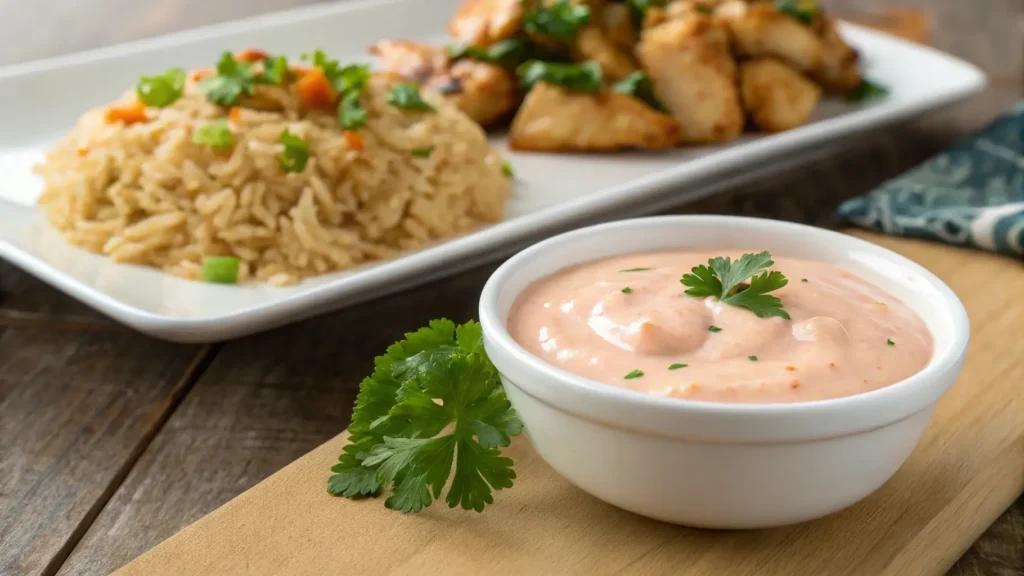
Traditional Sides: Fried Rice, Noodles, and Sauces
When serving hibachi chicken, the sides are just as important as the main dish. The classic choice is fried rice, cooked with soy sauce, garlic, eggs, and vegetables. You can make it extra special by tossing in shrimp or chicken scraps for a protein boost. Noodles stir-fried with soy sauce, butter, and garlic also make a wonderful pairing. Want more variety? Add steamed edamame, miso soup, or even a side of tempura veggies.
Plating Ideas for a Restaurant-Style Experience at Home
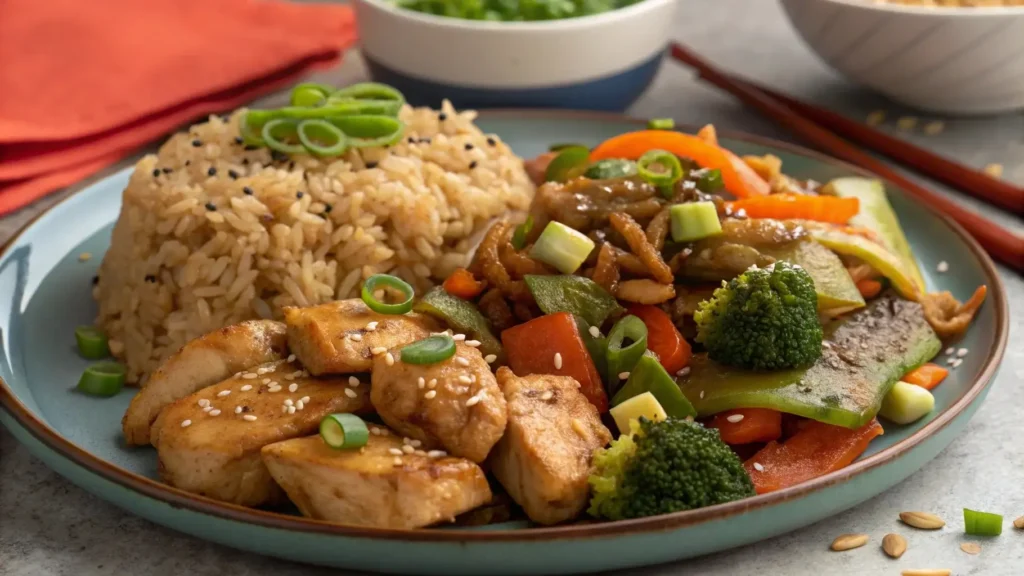
Presentation is key to creating that restaurant-like vibe. For a traditional setup, place the hibachi chicken at the center of the plate, surrounded by a generous portion of fried rice and sautéed vegetables. Garnish the chicken with sesame seeds and chopped green onions for an extra pop of flavor and color. Serve sauces like yum yum and soy sauce on the side in small dipping bowls.
Customizing Your Meal: Adding Steak, Shrimp, or Tofu
If you want to elevate your hibachi chicken recipe, mix things up by incorporating other proteins. Steak and shrimp are common additions, creating a classic surf-and-turf meal. For a plant-based option, tofu or seitan can be seasoned and cooked similarly to chicken. With a bit of creativity, you can easily transform this meal into a multi-protein feast.
Craving more ideas for bold and flavorful meals? Don’t miss out on this collection of hearty chicken recipes.
Healthier Alternatives and Customizations
Swapping Ingredients for a Low-Calorie Version
If you’re looking to cut down on calories, there are plenty of ways to tweak the traditional hibachi chicken recipe without compromising flavor. Instead of using butter, try a splash of olive oil or avocado oil. Swap white rice for quinoa or cauliflower rice to boost fiber and reduce carbs. Low-sodium soy sauce is a must if you want to control your salt intake.
Gluten-Free or Dairy-Free Modifications
Making this dish gluten-free is simple. Choose tamari or coconut aminos as substitutes for soy sauce. For a dairy-free version, replace the garlic butter with vegan butter or extra sesame oil. Most of the core ingredients are naturally free from gluten and dairy, making this an easy recipe to adapt.
Vegan and Vegetarian Hibachi Chicken Variations
To make a fully plant-based hibachi, swap the chicken with tofu, tempeh, or jackfruit. Tofu cubes, when marinated in soy sauce and garlic, develop a savory flavor similar to chicken. For extra texture, try searing marinated tempeh or crisping the tofu in a cornstarch coating before cooking.
Bonus Tip: Love experimenting with veggies? This recipe pairs wonderfully with stir-fried broccoli or cabbage for extra crunch. For more veggie-rich dishes, check out The Best Asian Broccoli Recipe.
Tips for Beginners and Advanced Cooks
Tips for Beginners: Simple Ways to Get It Right
- Prep Ingredients in Advance: Chop your chicken and vegetables before you start cooking. This prevents rushing and ensures everything cooks evenly.
- Use Medium-High Heat: Don’t crank the heat too high on your first try, as this can lead to burnt garlic and uneven cooking. Medium-high heat will give you a good sear without overcooking.
- Don’t Overcrowd the Pan: Cooking in smaller batches allows for proper browning, preventing a steamed, soggy texture.
- Start with Basic Seasonings: Salt, pepper, soy sauce, and garlic are enough to create a flavorful base. You can experiment with additional seasonings later.
- Taste as You Go: Don’t wait until the end to adjust seasoning—tasting mid-cook ensures a better balance of flavors.
Tips for Advanced Cooks: Taking Your Hibachi to the Next Level
- Master the Art of Caramelization: Adding a splash of soy sauce toward the end of cooking can enhance the dish by creating a rich, caramelized flavor.
- Experiment with Protein Blends: For a dynamic meal, combine chicken with shrimp or steak, adjusting the cooking times for each protein.
- Make Homemade Yum Yum Sauce: Instead of store-bought options, create your own sauce using mayo, rice vinegar, and a hint of smoked paprika for a personal touch.
- Use a Cast-Iron Skillet or Flat-Top Grill: If you have access to advanced equipment, such as a griddle, you’ll be able to achieve that authentic restaurant-style sear and flavor.
- Infuse Aromatics: Fry minced garlic and ginger in oil before adding the chicken to enhance depth of flavor.
With these tips, both beginners and experienced cooks can achieve a satisfying hibachi chicken recipe that’s bursting with flavor and texture.
Expert Tips for Perfecting Your Hibachi Chicken Recipe
Common Mistakes to Avoid
One of the biggest mistakes when cooking a hibachi chicken recipe is overcrowding the pan. If the chicken or veggies are packed too tightly, they’ll steam instead of searing, which can lead to a soggy texture. To avoid this, cook in batches if necessary and make sure each piece has room to brown. Another common misstep is overcooking the chicken. Since the pieces are small, they cook quickly. To keep them juicy, cook over medium-high heat and remove from the pan once the chicken reaches 165°F.
Additionally, avoid skipping the resting time. Letting the cooked chicken rest for a few minutes helps lock in moisture and enhances flavor. And don’t skimp on butter! The right balance of soy sauce and butter is what gives hibachi its signature richness.
How to Get That Smoky Hibachi Flavor at Home
Recreating the smoky, charred flavor of restaurant-style hibachi without a flat-top grill is easier than you think. Using a cast-iron skillet can give you that same effect because it retains high heat and creates an excellent sear. Another trick is to add a small splash of soy sauce near the end of cooking, allowing it to caramelize slightly. The combination of caramelization and high heat will help mimic that authentic hibachi taste.
Timing and Temperature Tricks
Timing is everything in hibachi cooking. Start by cooking the chicken first, as it takes the longest. Once the chicken is removed, quickly stir-fry the vegetables so they retain their crunch. Keep the pan hot throughout the process, but avoid cooking over extremely high heat, which can burn the garlic and other seasonings.
Frequently Asked Questions (FAQs)
1. What makes hibachi chicken different from teriyaki chicken?
Both dishes are rooted in Japanese cuisine, but they have distinct differences. Hibachi chicken is cooked on a hot grill or pan and typically seasoned with soy sauce, butter, garlic, and lemon juice. Teriyaki chicken, on the other hand, is marinated or glazed in a sweeter soy-based sauce that often includes sugar or honey. Hibachi focuses on bold, smoky flavors, while teriyaki leans toward sweet and savory notes.
2. Can I make hibachi chicken without a grill?
Yes, absolutely! You don’t need a fancy hibachi grill to enjoy a delicious hibachi chicken recipe at home. A cast-iron skillet, griddle, or non-stick pan works perfectly. The key is to maintain high heat and sear the chicken quickly for that golden-brown crust.
3. What can I use if I don’t have sesame oil?
If you don’t have sesame oil, you can use olive oil or avocado oil. However, sesame oil adds a nutty, distinct flavor, so consider adding a small amount of toasted sesame seeds as a substitute.
4. How long can I store leftovers, and what’s the best way to reheat them?
Leftover hibachi chicken can be stored in an airtight container in the fridge for 3 to 4 days. To reheat, use a skillet on medium heat with a bit of oil or butter to bring back its tenderness without drying it out. Avoid microwaving if possible, as it can make the chicken rubbery.
Conclusion and Final Thoughts
Recap of Key Steps for Success
Mastering the perfect hibachi chicken recipe comes down to a few essentials: high heat, properly prepped ingredients, and a balance of bold flavors. By searing the chicken and vegetables with garlic butter, soy sauce, and a splash of lemon, you can achieve that signature restaurant-style taste at home.
Encouragement to Try Customizations
Don’t be afraid to experiment! Whether you add shrimp, steak, or tofu, you can easily tailor this dish to your preferences. With the right techniques and a little creativity, you’ll have a satisfying meal that beats takeout any day. Happy cooking
Nutritional Benefits of Hibachi Chicken
A Protein-Packed Main Course
The hibachi chicken recipe is not just delicious—it’s also a nutritious meal option, thanks to its lean protein and veggie content. Chicken, particularly when prepared using boneless, skinless breasts or thighs, is a high-quality source of protein. Protein is essential for muscle repair, immune function, and overall cell health. A typical serving of hibachi chicken provides around 30-40 grams of protein, depending on portion size.
Rich in Vitamins and Minerals
The sautéed vegetables that accompany hibachi chicken—like zucchini, carrots, and onions—are loaded with essential vitamins, including vitamin C and potassium. Vitamin C supports the immune system and collagen production, while potassium helps regulate blood pressure. Adding garlic and ginger not only enhances flavor but also brings anti-inflammatory and immune-boosting properties.
Healthy Fats and Balanced Carbs
When cooked with moderate amounts of butter or sesame oil, the dish provides healthy fats that support brain and heart function. Pairing hibachi chicken with fried rice or a low-carb alternative, like cauliflower rice, allows you to control your carbohydrate intake. For an extra fiber boost, opt for brown rice or quinoa as your base.
Eating hibachi-style meals is a great way to enjoy a balance of macronutrients, especially if you control portion sizes and opt for low-sodium soy sauce.
